An ostrich is a type of large flightless bird.
Contents
Ostrich may also refer to:
An ostrich is a type of large flightless bird.
Ostrich may also refer to:
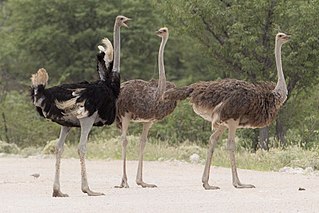
The common ostrich, or simply ostrich, is a species of flightless bird native to certain large areas of Africa. It is one of two extant species of ostriches, the only living members of the genus Struthio in the ratite order of birds. The other is the Somali ostrich, which was recognized as a distinct species by BirdLife International in 2014 having been previously considered a distinctive subspecies of ostrich.
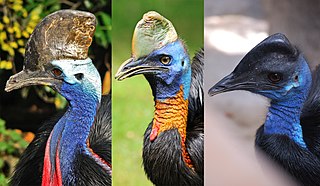
Cassowaries are flightless birds of the genus Casuarius in the order Casuariiformes. They are classified as ratites: flightless birds without a keel on their sternum bones. Cassowaries are native to the tropical forests of New Guinea, the Aru Islands (Maluku), and northeastern Australia.

A ratite is any of a group of mostly large, long-necked, and long-legged birds of the infraclass Palaeognathae. Kiwi, the exception, are much smaller and shorter-legged and are the only nocturnal extant ratites. All extant ratites are flightless.

Struthionidae is a family of flightless birds, containing the extant ostriches and their extinct relatives. The two extant species of ostrich are the common ostrich and Somali ostrich, both in the genus Struthio, which also contains several species known from Holocene fossils such as the Asian ostrich. The common ostrich is the more widespread of the two living species, and is the largest living bird species. The extinct genus Pachystruthio from the Late Pliocene-Early Pleistocene of Eurasia is one of the largest birds ever.
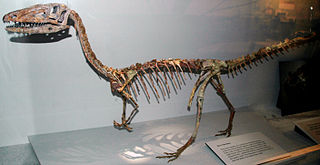
Theropoda, whose members are known as theropods, is a dinosaur clade that is characterized by hollow bones and three toes and claws on each limb. Theropods are generally classed as a group of saurischian dinosaurs. They were ancestrally carnivorous, although a number of theropod groups evolved to become herbivores and omnivores. Theropods first appeared during the Carnian age of the late Triassic period 231.4 million years ago (Ma) and included the majority of large terrestrial carnivores from the Early Jurassic until at least the close of the Cretaceous, about 66 Ma. In the Jurassic, birds evolved from small specialized coelurosaurian theropods, and are today represented by about 10,500 living species.
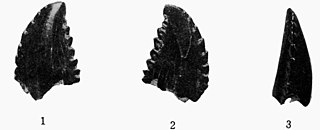
Troodon is a former wastebasket taxon and a potentially dubious genus of relatively small, bird-like theropod dinosaurs definitively known from the Campanian age of the Late Cretaceous period. It includes at least one species, Troodon formosus, known from Montana. Discovered in October 1855, T. formosus was among the first dinosaurs found in North America, although it was thought to be a lizard until 1877. Several well-known troodontid specimens from the Dinosaur Park Formation in Alberta were once believed to be members of this genus. However, recent analyses in 2017 have found this genus to be undiagnostic and referred some of these specimens to the genus Stenonychosaurus some to the genus Latenivenatrix, and some to the genus Pectinodon. The genus name is Ancient Greek for "wounding tooth", referring to the teeth, which were different from those of most other theropods known at the time of their discovery. The teeth bear prominent, apically oriented serrations. These "wounding" serrations, however, are morphometrically more similar to those of herbivorous reptiles, and suggest a possibly omnivorous diet.

Gallimimus is a genus of theropod dinosaur that lived in what is now Mongolia during the Late Cretaceous period, about seventy million years ago (mya). Several fossils in various stages of growth were discovered by Polish-Mongolian expeditions in the Gobi Desert of Mongolia during the 1960s; a large skeleton discovered in this region was made the holotype specimen of the new genus and species Gallimimus bullatus in 1972. The generic name means "chicken mimic", referring to the similarities between its neck vertebrae and those of the Galliformes. The specific name is derived from bulla, a golden capsule worn by Roman youth, in reference to a bulbous structure at the base of the skull of Gallimimus. At the time it was named, the fossils of Gallimimus represented the most complete and best preserved ornithomimid material yet discovered, and the genus remains one of the best known members of the group.

Oviraptoridae is a group of bird-like, herbivorous and omnivorous maniraptoran dinosaurs. Oviraptorids are characterized by their toothless, parrot-like beaks and, in some cases, elaborate crests. They were generally small, measuring between one and two metres long in most cases, though some possible oviraptorids were enormous. Oviraptorids are currently known only from the Late Cretaceous of Asia, with the most well-known species and complete specimens found only in the Gobi Desert of Mongolia and northwestern China.

Ostriches are large flightless birds. They are the heaviest and largest living birds, with adult common ostriches weighing anywhere between 140-320 lbs and laying the largest eggs of any living land animal. With the ability to run at 70 km/h (43.5 mph), they are the fastest birds on land. They are farmed worldwide, with significant industries in the Philippines and in Namibia. Ostrich leather is a lucrative commodity, and the large feathers are used as plumes for the decoration of ceremonial headgear. Ostrich eggs have been used by humans for millennia.

Anserimimus is a genus of ornithomimid theropod dinosaur, from the Late Cretaceous Period of what is now Mongolia. It was a lanky, fast-running animal, possibly an omnivore. From what fossils are known, it probably closely resembled other ornithomimids, except for its more powerful forelimbs.

Ornithomimosauria are theropod dinosaurs which bore a superficial resemblance to the modern-day ostrich. They were fast, omnivorous or herbivorous dinosaurs from the Cretaceous Period of Laurasia, as well as Africa and possibly Australia. The group first appeared in the Early Cretaceous and persisted until the Late Cretaceous. Primitive members of the group include Nqwebasaurus, Pelecanimimus, Shenzhousaurus, Hexing and Deinocheirus, the arms of which reached 2.4 m (8 feet) in length. More advanced species, members of the family Ornithomimidae, include Gallimimus, Struthiomimus, and Ornithomimus. Some paleontologists, like Paul Sereno, consider the enigmatic alvarezsaurids to be close relatives of the ornithomimosaurs and place them together in the superfamily Ornithomimoidea.

Struthiomimus, meaning "ostrich-mimic", is a genus of ornithomimid dinosaurs from the late Cretaceous of North America. Ornithomimids were long-legged, bipedal, ostrich-like dinosaurs with toothless beaks. The type species, Struthiomimus altus, is one of the more common, smaller dinosaurs found in Dinosaur Provincial Park; their overall abundance—in addition to their toothless beak—suggests that these animals were mainly herbivorous or omnivorous, rather than purely carnivorous, if at all. Similar to the modern extant ostriches, emus, and rheas, ornithomimid dinosaurs likely lived as opportunistic omnivores, supplementing a largely plant-based diet with a variety of small mammals, reptiles, amphibians, insects, invertebrates, and anything else they could fit into their mouth, as they foraged.
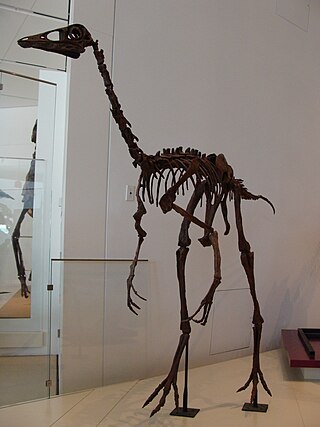
Ornithomimus is a genus of ornithomimid theropod dinosaurs from the Campanian and Maastrichtian ages of Late Cretaceous Western North America. Ornithomimus was a swift, bipedal dinosaur which fossil evidence indicates was covered in feathers and equipped with a small toothless beak that may indicate an omnivorous diet. It is usually classified into two species: the type species, Ornithomimus velox, and a referred species, Ornithomimus edmontonicus. O. velox was named in 1890 by Othniel Charles Marsh on the basis of a foot and partial hand from the Denver Formation of Colorado. Another seventeen species have been named since then, though almost all of them have been subsequently assigned to new genera or shown to be not directly related to Ornithomimus velox. The best material of species still considered part of the genus has been found in Alberta, representing the species O. edmontonicus, known from several skeletons from the Horseshoe Canyon Formation. Additional species and specimens from other formations are sometimes classified as Ornithomimus, such as Ornithomimus samueli from the earlier Dinosaur Park Formation.

Struthiosaurus is a genus of nodosaurid dinosaurs, from the Late Cretaceous period (Santonian-Maastrichtian) of Austria, Romania, France and Hungary in Europe. It was a small dinosaur, measuring 2–3 m (6.6–9.8 ft) in length and weighing 300–400 kg (660–880 lb).
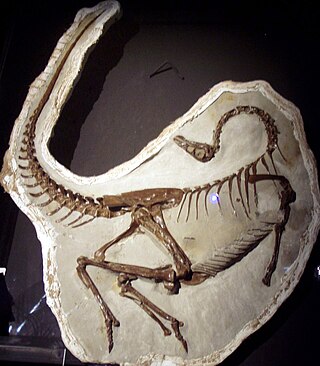
Ornithomimidae is a family of theropod dinosaurs which bore a superficial resemblance to modern ostriches. Ornithomimids were fast, omnivorous or herbivorous dinosaurs known mainly from the Late Cretaceous Period of Laurasia, though they have also been reported from the Lower Cretaceous Wonthaggi Formation of Australia.

The evolution of birds began in the Jurassic Period, with the earliest birds derived from a clade of theropod dinosaurs named Paraves. Birds are categorized as a biological class, Aves. For more than a century, the small theropod dinosaur Archaeopteryx lithographica from the Late Jurassic period was considered to have been the earliest bird. Modern phylogenies place birds in the dinosaur clade Theropoda. According to the current consensus, Aves and a sister group, the order Crocodilia, together are the sole living members of an unranked reptile clade, the Archosauria. Four distinct lineages of bird survived the Cretaceous–Paleogene extinction event 66 million years ago, giving rise to ostriches and relatives (Palaeognathae), waterfowl (Anseriformes), ground-living fowl (Galliformes), and "modern birds" (Neoaves).

Nemegtomaia is a genus of oviraptorid dinosaur from what is now Mongolia that lived in the Late Cretaceous Period, about 70 million years ago. The first specimen was found in 1996, and became the basis of the new genus and species N. barsboldi in 2004. The original genus name was Nemegtia, but this was changed to Nemegtomaia in 2005, as the former name was preoccupied. The first part of the generic name refers to the Nemegt Basin, where the animal was found, and the second part means "good mother", in reference to the fact that oviraptorids are known to have brooded their eggs. The specific name honours the palaeontologist Rinchen Barsbold. Two more specimens were found in 2007, one of which was found on top of a nest with eggs, but the dinosaur had received its genus name before it was found associated with eggs.

Avemetatarsalia is a clade of diapsid reptiles containing all archosaurs more closely related to birds than to crocodilians. The two most successful groups of avemetatarsalians were the dinosaurs and pterosaurs. Dinosaurs were the largest terrestrial animals for much of the Mesozoic Era, and one group of small feathered dinosaurs has survived up to the present day. Pterosaurs were the first flying vertebrates and persisted through the Mesozoic before dying out at the Cretaceous-Paleogene (K-Pg) extinction event. Both dinosaurs and pterosaurs appeared in the Triassic Period, shortly after avemetatarsalians as a whole. The name Avemetatarsalia was first established by British palaeontologist Michael Benton in 1999. An alternate name is Pan-Aves, or "all birds", in reference to its definition containing all animals, living or extinct, which are more closely related to birds than to crocodilians.

This timeline of tyrannosaur research is a chronological listing of events in the history of paleontology focused on the tyrannosaurs, a group of predatory theropod dinosaurs that began as small, long-armed bird-like creatures with elaborate cranial ornamentation but achieved apex predator status during the Late Cretaceous as their arms shrank and body size expanded. Although formally trained scientists did not begin to study tyrannosaur fossils until the mid-19th century, these remains may have been discovered by Native Americans and interpreted through a mythological lens. The Montana Crow tradition about thunder birds with two claws on their feet may have been inspired by isolated tyrannosaurid forelimbs found locally. Other legends possibly inspired by tyrannosaur remains include Cheyenne stories about a mythical creature called the Ahke, and Delaware stories about smoking the bones of ancient monsters to have wishes granted.

This timeline of ornithomimosaur research is a chronological listing of events in the history of paleontology focused on the ornithomimosaurs, a group of bird-like theropods popularly known as the ostrich dinosaurs. Although fragmentary, probable, ornithomimosaur fossils had been described as far back as the 1860s, the first ornithomimosaur to be recognized as belonging to a new family distinct from other theropods was Ornithomimus velox, described by Othniel Charles Marsh in 1890. Thus the ornithomimid ornithomimosaurs were one of the first major Mesozoic theropod groups to be recognized in the fossil record. The description of a second ornithomimosaur genus did not happen until nearly 30 years later, when Henry Fairfield Osborn described Struthiomimus in 1917. Later in the 20th century, significant ornithomimosaur discoveries began occurring in Asia. The first was a bonebed of "Ornithomimus" asiaticus found at Iren Debasu. More Asian discoveries took place even later in the 20th century, including the disembodied arms of Deinocheirus mirificus and the new genus Gallimimus bullatus. The formal naming of the Ornithomimosauria itself was performed by Rinchen Barsbold in 1976.